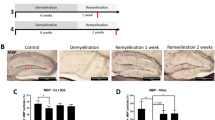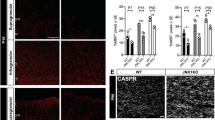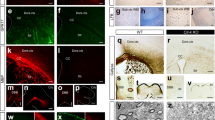Abstract
The mechanisms that regulate the developmental potential of adult neural progenitor populations under physiological and pathological conditions remain poorly defined. Glutamic acid decarboxylase 65 (GAD65)- and Doublecortin (Dcx)-expressing cells constitute major progenitor populations in the adult mouse subventricular zone (SVZ). Under normal physiological conditions, SVZ-derived GAD65-positive and Dcx-positive cells expressed the transcription factor Pax6 and migrated along the rostral migratory stream to the olfactory bulb to generate interneurons. After lysolecithin-induced demyelination of corpus callosum, however, these cells altered their molecular and cellular properties and migratory path. Demyelination upregulated chordin in the SVZ, which redirected GAD65-positive and Dcx-positive progenitors from neuronal to glial fates, generating new oligodendrocytes in the corpus callosum. Our findings suggest that the lineage plasticity of SVZ progenitor cells could be a potential therapeutic strategy for diseased or injured brain.
This is a preview of subscription content, access via your institution
Access options
Subscribe to this journal
Receive 12 print issues and online access
$209.00 per year
only $17.42 per issue
Buy this article
- Purchase on Springer Link
- Instant access to full article PDF
Prices may be subject to local taxes which are calculated during checkout








Similar content being viewed by others

Accession codes
References
Doetsch, F., Garcia-Verdugo, J.M. & Alvarez-Buylla, A. Regeneration of a germinal layer in the adult mammalian brain. Proc. Natl. Acad. Sci. USA 96, 11619–11624 (1999).
Palmer, T.D., Markakis, E.A., Willhoite, A.R., Safar, F. & Gage, F.H. Fibroblast growth factor 2 activates a latent neurogenic program in neural stem cells from diverse regions of the adult CNS. J. Neurosci. 19, 8487–8497 (1999).
Palmer, T.D., Willhoite, A.R. & Gage, F.H. Vascular niche for adult hippocampal neurogenesis. J. Comp. Neurol. 425, 479–494 (2000).
Temple, S. The development of neural stem cells. Nature 414, 112–117 (2001).
Shen, Q., Zhong, W., Jan, Y.N. & Temple, S. Asymmetric Numb distribution is critical for asymmetric cell division of mouse cerebral cortical stem cells and neuroblasts. Development 129, 4843–4853 (2002).
Alvarez-Buylla, A. & Garcia-Verdugo, J.M. Neurogenesis in adult subventricular zone. J. Neurosci. 22, 629–634 (2002).
Alvarez-Buylla, A. & Lim, D.A. For the long run: maintaining germinal niches in the adult brain. Neuron 41, 683–686 (2004).
Coskun, V. & Luskin, M.B. Intrinsic and extrinsic regulation of the proliferation and differentiation of cells in the rodent rostral migratory stream. J. Neurosci. Res. 69, 795–802 (2002).
Hack, M.A. et al. Neuronal fate determinants of adult olfactory bulb neurogenesis. Nat. Neurosci. 8, 865–872 (2005).
Kim, Y., Comte, I., Szabo, G., Hockberger, P. & Szele, F.G. Adult mouse subventricular zone stem and progenitor cells are sessile and epidermal growth factor receptor negatively regulates neuroblast migration. PLoS One 4, e8122 (2009).
Nait-Oumesmar, B. et al. Progenitor cells of the adult mouse subventricular zone proliferate, migrate and differentiate into oligodendrocytes after demyelination. Eur. J. Neurosci. 11, 4357–4366 (1999).
Ligon, K.L. et al. Development of NG2 neural progenitor cells requires Olig gene function. Proc. Natl. Acad. Sci. USA 103, 7853–7858 (2006).
Menn, B. et al. Origin of oligodendrocytes in the subventricular zone of the adult brain. J. Neurosci. 26, 7907–7918 (2006).
Aguirre, A., Dupree, J., Mangin, J.M. & Gallo, V. A functional role for EGFR signaling in myelination and remyelination. Nat. Neurosci. 10, 990–1002 (2007).
Nait-Oumesmar, B., Picard-Riéra, N., Kerninon, C. & Baron-Van Evercooren, A . The role of SVZ-derived neural precursors in demyelinating diseases: From animal models to multiple sclerosis. J. Neurol. Sci. 265, 26–31 (2008).
Baumann, N. & Pham-Dinh, D. Biology of oligodendrocytes and myelin in the mammalian central nervous system. Physiol. Rev. 81, 871–927 (2001).
Levine, J.M., Reynolds, R. & Fawcett, J.W. The oligodendrocyte precursor cell in health and disease. Trends Neurosci. 24, 39–47 (2001).
Jessberger, S., Toni, N., Clemenson, G.D. Jr., Ray, J. & Gage, F.H. Directed differentiation of hippocampal stem/progenitor cells in the adult brain. Nat. Neurosci. 11, 888–893 (2008).
Buffo, A. et al. Expression pattern of the transcription factor Olig2 in response to brain injuries: implications for neuronal repair. Proc. Natl. Acad. Sci. USA 102, 18183–18188 (2005).
Walker, T.L., Yasuda, T., Adams, D.J. & Bartlett, P.F. The doublecortin-expressing population in the developing and adult brain contains multipotential precursors in addition to neuronal-lineage cells. J. Neurosci. 27, 3734–3742 (2007).
Ligon, K.L., Fancy, S.P., Franklin, R.J. & Rowitch, D.H. Olig gene function in CNS development and disease. Glia 54, 1–10 (2006).
Canoll, P. & Goldman, J. The interface between glial progenitors and gliomas. Acta Neuropathol. 116, 465–477 (2008).
Franklin, R.J. & Ffrench-Constant, C. Remyelination in the CNS: from biology to therapy. Nat. Rev. Neurosci. 9, 839–855 (2008).
Staugaitis, S.M. & Trapp, B.D. NG2-positive glia in the human central nervous system. Neuron Glia Biol. 5, 35–44 (2009).
Heins, N. et al. Glial cells generate neurons: the role of the transcription factor Pax6. Nat. Neurosci. 5, 308–315 (2002).
Jablonska, B. et al. Cdk2 is critical for proliferation and self-renewal of neural progenitor cells in the adult subventricular zone. J. Cell Biol. 179, 1231–1245 (2007).
Goings, G.E., Sahni, V. & Szele, F.G. Migration patterns of subventricular zone cells in adult mice change after cerebral cortex injury. Brain Res. 996, 213–226 (2004).
Chen, H.L. & Panchision, D.M. Concise review: bone morphogenetic protein pleiotropism in neural stem cells and their derivatives–alternative pathways, convergent signals. Stem Cells 25, 63–68 (2007).
Schuurmans, C. & Guillemot, F. Molecular mechanisms underlying cell fate specification in the developing telencephalon. Curr. Opin. Neurobiol. 12, 26–34 (2002).
See, J.M.P. & Grinspan, J.B.P. Sending mixed signals: bone morphogenetic protein in myelination and demyelination. J. Neuropathol. Exp. Neurol. 68, 595–604 (2009).
Mehler, M.F., Mabie, P.C., Zhu, G., Gokhan, S. & Kessler, J.A. Developmental changes in progenitor cell responsiveness to bone morphogenetic proteins differentially modulate progressive CNS lineage fate. Dev. Neurosci. 22, 74–85 (2000).
Mekki-Dauriac, S., Agius, E., Kan, P. & Cochard, P. Bone morphogenetic proteins negatively control oligodendrocyte precursor specification in the chick spinal cord. Development 129, 5117–5130 (2002).
Gomes, W.A., Mehler, M.F. & Kessler, J.A. Transgenic overexpression of BMP4 increases astroglial and decreases oligodendroglial lineage commitment. Dev. Biol. 255, 164–177 (2003).
Samanta, J. et al. BMPR1a Signaling determines numbers of oligodendrocytes and Calbindin-expressing interneurons in the cortex. J. Neurosci. 27, 7397–7407 (2007).
See, J. et al. BMP signaling mutant mice exhibit glial cell maturation defects. Mol. Cell. Neurosci. 35, 171–182 (2007).
Wang, Y. et al. Bone morphogenetic protein–6 reduces ischemia-induced brain damage in rats. Stroke 32, 2170–2178 (2001).
Kondo, T. Common mechanism underlying oligodendrocyte development and oligodendrogliomagenesis. Brain Nerve 61, 741–751 (2009).
Hampton, D.W. et al. A potential role for bone morphogenetic protein signalling in glial cell fate determination following adult central nervous system injury in vivo. Eur. J. Neurosci. 26, 3024–3035 (2007).
Chou, J. et al. Neuroregenerative effects of BMP7 after stroke in rats. J. Neurol. Sci. 240, 21–29 (2006).
Shen, H., Luo, Y., Kuo, C.-C. & Wang, Y. BMP7 reduces synergistic injury induced by methamphetamine and ischemia in mouse brain. Neurosci. Lett. 442, 15–18 (2008).
Israelsson, C. et al. Genetically modified bone morphogenetic protein signaling alters traumatic brain injury-induced gene expression responses in the adult mouse. J. Neurosci. Res. 84, 47–57 (2006).
Bani-Yaghoub, M. et al. Neuroregenerative strategies in the brain: emerging significance of bone morphogenetic protein 7 (BMP7). Biochem. Cell Biol. 86, 361–369 (2008).
Zhao, C., Fancy, S.P.J., Kotter, M.R., Li, W.-W. & Franklin, R.J.M. Mechanisms of CNS remyelination—the key to therapeutic advances. J. Neurol. Sci. 233, 87–91 (2005).
Fuller, M.L. et al. Bone morphogenetic proteins promote gliosis in demyelinating spinal cord lesions. Ann. Neurol. 62, 288–300 (2007).
Ara, J. et al. Bone morphogenetic proteins 4, 6 and 7 are up-regulated in mouse spinal cord during experimental autoimmune encephalomyelitis. J. Neurosci. Res. 86, 125–135 (2008).
Colak, D. et al. Adult neurogenesis requires Smad4-mediated bone morphogenic protein signaling in stem cells. J. Neurosci. 28, 434–446 (2008).
Chang, A. et al. Neurogenesis in the chronic lesions of multiple sclerosis. Brain 131, 2366–2375 (2008).
Deininger, M., Meyermann, R. & Schluesener, H. Detection of two transforming growth factor-beta-related morphogens, bone morphogenetic proteins-4 and -5, in RNA of multiple sclerosis and Creutzfeldt-Jakob disease lesions. Acta Neuropathol. 90, 76–79 (1995).
Aguirre, A.A., Chittajallu, R., Belachew, S. & Gallo, V. NG2-expressing cells in the subventricular zone are type C-like cells and contribute to interneuron generation in the postnatal hippocampus. J. Cell Biol. 165, 575–589 (2004).
Aguirre, A., Rizvi, T.A., Ratner, N. & Gallo, V. Overexpression of the epidermal growth factor receptor confers migratory properties to nonmigratory postnatal neural progenitors. J. Neurosci. 25, 11092–11106 (2005).
Acknowledgements
We thank F. Gage (Salk Institute) and J. Goldman (Columbia University) for the gift of pNIT-GFP and dS-Red retrovirus and D. Rowitch (University of California San Francisco) for the gift of antibodies to Olig2. We thank T. Hawley for assistance with FACS sorting. We are particularly grateful to J. Corbin for discussion. This work was supported by US National Institutes of Health grants R01NS045702 and R01NS056427 to V.G., K99NS057944 to A.A., R01NS047344 and R01AG024984 to H.S. and R01NS048271 to G.M. and by the Hungarian National Office for Research and Technology GVOP-3.1.1.-2004-05-0230-/3.0 to G.S. and US National Institutes of Health Intellectual and Developmental Disabilities Research Center P30HD40677 to V.G.
Author information
Authors and Affiliations
Contributions
B.J. and A.A. designed, performed and analyzed all of the experiments. M.R. performed some of the in vivo experiments, cell imaging and cell counting. G.S. generated and provided the GAD65-GFP mice. Y.K., K.A.S., G.M. and H.S. generated and provided the Dcx-CreERT2 mice. V.G. designed the experiments with B.J. and A.A., supervised the project and wrote the manuscript with input from B.J.
Corresponding author
Ethics declarations
Competing interests
The authors declare no competing financial interests.
Supplementary information
Supplementary Text and Figures
Supplementary Figures 1–6 (PDF 4108 kb)
Rights and permissions
About this article
Cite this article
Jablonska, B., Aguirre, A., Raymond, M. et al. Chordin-induced lineage plasticity of adult SVZ neuroblasts after demyelination. Nat Neurosci 13, 541–550 (2010). https://doi.org/10.1038/nn.2536
Received:
Accepted:
Published:
Issue Date:
DOI: https://doi.org/10.1038/nn.2536
This article is cited by
-
Culture Protocol and Transcriptomic Analysis of Murine SVZ NPCs and OPCs
Stem Cell Reviews and Reports (2023)
-
The Effects of Cuprizone on Murine Subventricular Zone-Derived Neural Stem Cells and Progenitor Cells Grown as Neurospheres
Molecular Neurobiology (2023)
-
Specific Blockade of Bone Morphogenetic Protein-2/4 Induces Oligodendrogenesis and Remyelination in Demyelinating Disorders
Neurotherapeutics (2021)
-
Differential Modulators of NG2-Glia Differentiation into Neurons and Glia and Their Crosstalk
Cellular and Molecular Neurobiology (2021)
-
Involvement of Wnt7a in the role of M2c microglia in neural stem cell oligodendrogenesis
Journal of Neuroinflammation (2020)


